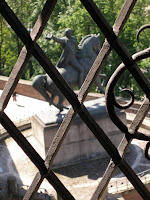
16th century Poland had extensive connections with Italy; students from Poland studied at universities in Italy (Copernicus was only one of many). At home a Polish king had married Bona Sforza of Milan. She imported architects and artisans of all kinds. You can see this Italian influence in the Renaissance-style renovations of the Royal Palace on the Wawel and the Cloth Hall in the Market Square. Today, some 5 centuries later, the Italian connection is alive again. Major types of restaurants this year in Cracow are Italian, Italo-Polish, Polish-Italian (followed by Japanese and street kebob---a real food bargain).
My friend Marek recommended Corleone (elegant Italian) and Trzy Papriczki (pizza) in Poselska St. and with open air courtyards, cozy even in light rain. Miod Malina dominates the corner of Grodzka and Poselska. Finally, another Italian discovery: Del Papa, on the last night in Cracow. It's obscured this year because nearby Plac Szczepanski is currently torn up. Formerly a car park, in preparation of soccer in 2012, the plac is being renovated. The plac is bounded by galleries (with a show of Witkacy photographs), the Old Theatre, and Cracow's seccesionist-style art museum. Walking back to the hotel at almost midnight through the Planty on damp spring night---here's to the Italians!




.JPG)








.JPG)
.JPG)













.JPG)












